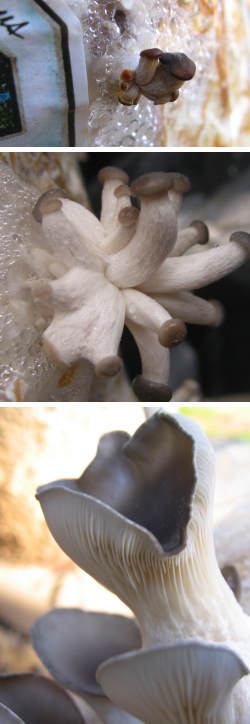
How to initiate mushroom fruiting
 No matter whether you've gone
the cheap, at-home route of growing
mushroom spawn on cardboard or carefully followed the
optimal growing instructions using petri dishes, jars of grain, and
sawdust, mycelium is
just mycelium. I've been talking about this stuff for two weeks,
and I know you're anxious to get to the mushrooms themselves.
No matter whether you've gone
the cheap, at-home route of growing
mushroom spawn on cardboard or carefully followed the
optimal growing instructions using petri dishes, jars of grain, and
sawdust, mycelium is
just mycelium. I've been talking about this stuff for two weeks,
and I know you're anxious to get to the mushrooms themselves.
Mushrooms aren't like
plants which pay attention to day length and then bloom and fruit on
cue. Instead, you need to give your mycelium a hint when it's
time to get some mushrooms. First of all, the mycelium has to
have completely colonized the substrate --- reaching the end of its
habitat is one natural cue that prompts mushroom formation.
When growing mycelium in
an unnatural habitat, like plastic bags, you will also want to lower
the carbon dioxide levels, which simulates the fungus reaching the
outside world. Many growers punch small holes in the bags where
they want the mushrooms to emerge. Increasing the light levels at
least slightly also tells the mycelium that it has reached the surface
and should send up a fruitbody.
Meanwhile, your mushroom
is probably waiting for a specific season (though which one depends on
the species you are growing.) Increase the humidity to nearly
100% and either increase or decrease the temperature to signal a
seasonal shift. Oyster mushrooms are split into warm weather
varieties which should be prompted to fruit at temperatures between 50
and 75 degrees Fahrenheit and cold weather varieties that need a few
days at 50 to 60 degrees Fahrenheit.
If you give your
mycelium the right cues, they should form what are called primordia ---
little buttons on the surface that can grow into mushrooms. To
prompt the mushrooms to develop properly, lower the humidity a bit and
retain lower carbon dioxide levels and moderate light. If you
want mushrooms fast, raise the temperature, or just leave the
temperature where it's at and wait a few more days. Soon, you'll
be feasting on gourmet mushrooms!
This post is part of our Growing Gourmet Mushrooms lunchtime series.
Read all of the entries:
|
Want more in-depth information? Browse through our books.
Or explore more posts by date or by subject.
About us: Anna Hess and Mark Hamilton spent over a decade living self-sufficiently in the mountains of Virginia before moving north to start over from scratch in the foothills of Ohio. They've experimented with permaculture, no-till gardening, trailersteading, home-based microbusinesses and much more, writing about their adventures in both blogs and books.
Want to be notified when new comments are posted on this page? Click on the RSS button after you add a comment to subscribe to the comment feed, or simply check the box beside "email replies to me" while writing your comment.
